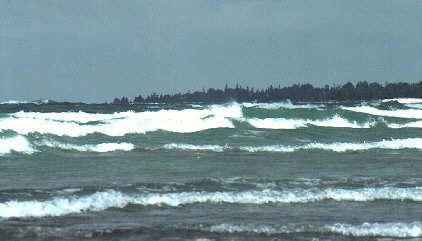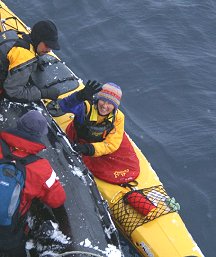
by Louise Adie
I had only intended to start kayaking as a way to build upper body strength for Nordic skiing. Famous last words.
My paddling had been limited to 8- and 12-mile outings on Cayuga Lake here in the Finger Lakes Region of central New York State. So after two years of four-season paddling (jumping in my boat in full ski clothing when the snow was too scant) I began what would become two years of planning for a small expedition to celebrate my 50th birthday.
Four years after testing, then buying, my first kayak I stood poised on the shore of Lake Ontario about to undertake a 6-week, 450-mile journey, just me, my kayak and the lake.
It was after I purchased my second boat, the Derek Hutchinson-designed Slipstream by Current Designs, that I read the review in Sea Kayaker: “…well suited for day trips only.” I probably wouldn’t have bought that boat had I read the review first. As it turned out I couldn’t have picked a better boat. Being high waisted with a short torso I prefer its low profile. Minimal stowage space kept my cargo load light, forcing me to choose my gear and clothing sensibly. No room for the kitchen sink here. Plus it handles itself beautifully in heavy and confused waves.
The first 325 miles of the trip were pleasant enough. A mixture of strings of glorious late summer days, spent paddling in bathing suit or topless, evenly spaced with the standard Great Lakes “three-day blows” ate up the first four weeks of my trip. Sleeping on beaches in torrential downpours, or under a canopy of stars on clear nights, I was nearly lulled into a rhythm of long paddling days and forced shoretime retreat when storm driven waves got too big.
Showers and laundries were easy to find at the marinas and I actually had time to catch up on reading and writing postcards on those three-day sit-outs. Meeting strangers at my many stops became the joyful highlight of my trip.
Then the hurricane watch hit. Sensing something sinister in the atmosphere that morning and having no explanation why the wind was suddenly so strong and the waves so huge, I came ashore in a small, protected cove, frantically trying to find a weather report. An FM station in Rochester was advising people to get off and away from the lake, a hurricane was bearing down on the city from Lake Erie, and judging by the map I was right in its path, just across the lake.
The next half hour was scramble time as I lashed down the bow and the stern to two solid looking trees behind a small summer cottage, emptied all my gear into a tiny shed, set up my tent with as many guy lines as I could find, and prepared to wait it out. Before the torrents of rain hit I watched the waves build out beyond the point. In my journal I recorded “…eerily powerful with its enormous waves, sickly green cast and spindrift sailing off the crests of the frothing turbulence, the wind rushing so hard and fast it outruns the waves. The constant roar is deafening. The profiles of the waves pushing northeast past the point reveal curling, snarling waves of 10 to 12 feet, sudden eruptions of crests boiling up to 15 feet. This was the stranger I feared lurked within the relatively calm friend who had accompanied me these past four weeks.” In this shallow part of the lake, without the privilege of depth, as in the ocean, these waves stack up ferociously.
After the hurricane watch passed, the lake never really calmed down much again. It was early October after all.
Anxious to finish this venture and tired of waiting, I hitched a ride in a pick-up truck, backward to an inland waterway, still considered to be part of Lake Ontario. I figured I could get some mileage in on the protected Bay of Quinte then come out into Prince Edward Bay, in all adding an extra thirty miles. If it were still blowing hard at least I’d be in the protection of the lee shore.
I then waited two days at a marina in one of the most remote areas of the entire lake, watching as boat after boat got plucked from the water, drydocked for the winter. I smelled snow in the air. An experienced Danish sailor greeted me on the third morning with his usual offering of coffee, but with this advice: “You’d better get your ass in gear. You’ve got two days of good weather then all hell’s gonna break loose.” I put the cup of coffee down and ran. In twenty minutes I was back on the water.
I had come to the most terrifying aspect of my trip, the area I had dreaded for two years, and I had only two days to pull it off: a 20-mile open-water crossing through shipping lanes to a tiny uninhabited island, then another 18-mile open-water through more shipping lanes, all in the easternmost end of the lake, an area famous for monster waves preceding quickly building heavy storms from the west. At the bottom of the lake in this area lay shipwrecks more numerous than all the others totalled together. All the way around the lake power boaters and sailors had warned me of these treacherous waters. Most of them choose the inland waterways, adding an extra 50 to 60 miles. I didn’t have that kind of time, nor did I wish to be crammed into these waterways with their treacherous currents and the ever-present ocean going freighters.
The first day was pleasant, warmish, a long hard paddle, with waves never reaching more than a foot. If the second day were like this the dreaded crossing would be a breeze.
As I finished setting up my tent on a narrow and exposed beach I noticed a sickening little breeze on my shoulder coming from the west. The hair on my arms stood up. I called a friend about 70 miles away who alerted me to more bad weather on the way. “You’re not going to like this,” he said. “Waves building to 4’ overnight and 6’ by mid-morning. Rain and heavy wind for the next three days. Have you got enough food?” I had.
I thanked him and hung up. I moved my tent to a beach on a protected cove, greeted in the beam of my headlamp by the reflective eyes of a fox and a beaver, a good omen I thought.
During the course of the next two days the wind shifted from the west to northwest to north then settling in from the northeast. My little pebbled beach was disappearing under the rising waves, leaving me nothing but a plateau of poison ivy. The other side of the island was cliffs.
I spent the time pleasantly enough but I was getting dreadfully tired of all the storm commotion and started believing the weather had changed for the duration of the year and that my time had simply run out.
That night I decided I had had enough. It was rescue time. Call the Coast Guard; be done with it. But at least wait until morning – why make them come out in this nastiness, in the dark. In these howling conditions it would be a logistical nightmare, both for them and for me.
At 7:30 a.m. I called 911. In the middle of the briefest of explanations the cell phone charge went dead. I had foolishly wasted twenty minutes of charge on a phone conversation with a news reporter on my way to the island. The article never appeared in the paper and the bill for that call totalled $45. For the rest of the morning as each freighter passed in the shipping lanes I ran from end to end of the island waving my t-shirted paddle at them, offering reflective flashes with my mirror. No helicopter, no rescue boats, no blast of acknowledgement from the freighters. By 12:30 p.m. the storm had blown itself out and I was on the water again. It was clear I was meant to finish this trip under my own steam.
For the next four hours I paddled as hard and as fast as I could without a break, my heart in my throat. Who knew if this was just a lull between storms, if another storm was building from the west. I couldn’t get a weather report for the area. I just had to trust my luck. I had another 18-mile open-water crossing ahead of me. If a storm did blow up I assumed I would be turning tail at the last possible moment, riding the waves toward the St. Lawrence River, hoping to land on the New York side in some protected cove. I knew the shoreline was mostly soaring cliffs, so a protected cove might not be a possibility.
At one point a freighter was bearing down on me then suddenly veered away from its path. It had turned exactly where it was supposed to be according to a later check of the nautical chart. It if hadn’t it might have been a near miss. I don’t know – where do you go to get out of the way of a speeding freighter?
I landed safely on the shores of New York back in familiar territory. I made several attempts at finishing the trip over the course of the next five days, but 3 to 4 miles a day wasn’t going to get me anywhere. The weather had now changed for good. Unnerved, cold, wet, tired, lonely and simply out of time I vowed to return the following year to finish what I had started. If not for the record books as the first person to ever circumnavigate Lake Ontario, then for my own personal sense of accomplishment.

It was a horribly restless year, this unfinished business nagging at me.
One year later I did return to the lake knocking off that remaining 50 miles in four days. I left behind a lake at peace, and found peace within myself.
What I brought back were stories too numerous to tell in one sitting, and through my newspaper accounts an inspiration freely given to those who have always dreamed of doing something big but have always put it off. Already two men in their sixties from separate towns have revealed to me their dream of hiking the Appalachian Trail. With dancing eyes and a quickening flush of the cheeks they’ve told me that after reading my story they now have the courage to do it themselves. I know I’ve gotten my inspiration from others who have gone before and have been kind enough to come back and tell us their stories.
Louise Adie is a kayaker who lives near Ithaca N.Y.; she works as a kayak guide in Antarctica during our winter. She is planning a circumnavigation of Georgian Bay next summer.
